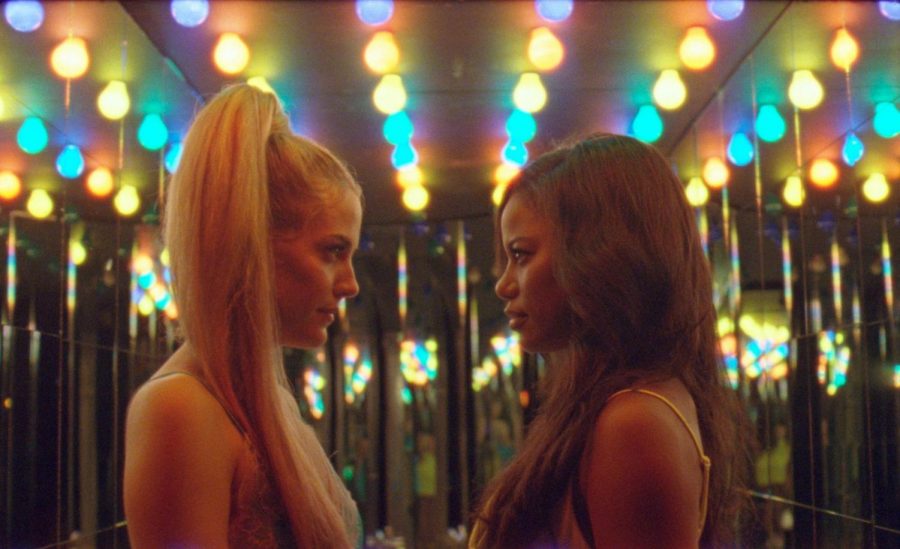“Zola” Review: A modern Floridian fairytale
Janicza Bravo’s sophomore feature is a dazzling adaptation of a legendary Twitter thread.
“Zola,” directed by NYU alumna Janicza Bravo, is a 2020 comedy-drama film based on a twitter thread. “Zola” is now in theaters and available to rent on demand. (Image courtesy of A24)
August 25, 2021
If you were on Twitter in 2015, before it was ruled by toxic sanctimony and political scorn, you might remember it as a sort of Wild West — uncharted territory with outlaws, lack of government and fantastical tales. Among the most legendary of these stories was penned on Oct. 27, when A’Ziah King recounted the vulgar, outrageous details of a star-crossed journey through a ring of Florida strip clubs in a fabled series of 148 tweets. After the tale was widely circulated on the internet, it didn’t take long for Hollywood to knock on her door.
Six years later, “Zola” has materialized as the first narrative feature film based on a Twitter thread. Directed by NYU alumna Janicza Bravo (“Lemon”) from a screenplay she wrote with Jeremy O. Harris (Tony-nominated “Slave Play”), the film is a dazzling and faithful adaptation of the original tweets — vignettes of Odyssean proportion which stand together at one hour and 30 minutes. Usually, I would describe the opening scene at this point in the review, but King’s original summary is enough: “So I met this white bitch at Hooters.”
Like the original Tweets, the plot of the movie is simple enough: “Zola” is the story of its titular character, who befriends Stefani (Riley Keough), the aforementioned “white bitch” in an all too Floridian meet-cute at a restaurant booth. Captivated by Stefani’s hoop earrings, braided hair extensions, janky charm and classy pickup line — “Damn, bitch! You got perfect titties!” — Zola (Taylour Paige), consents to a spontaneous weekend excursion to Tampa.
An important part of their bond, both Zola and Stefani are strippers. They’ve come to Florida in pursuit of a few lucrative dancing gigs arranged for them by X (Colman Domingo), a mysterious man whose identity — amid random switches of his accent and name — is vaguely delineated by Stefani as her roommate. Also accompanying them is Derrek (Nicholas Braun), Stefani’s lovable halfwitted boyfriend whose goofy mantra — “We Makin’ Shmoney” — doubles as Zola’s plan for the weekend. This intention, of course, does not work out like she envisioned— after all, it’s sex work in Florida.
Zola soon finds out that X is Stefani’s pimp and, before Zola has the chance to escape, the trip itinerary substitutes dancing with prostitution. She soon finds herself trapped in a cautionary tale of sex trafficking, greed and betrayal — something that, in a Q&A session hosted by NYU’s Program Board last spring, Bravo referred to as a modern-day fairytale.
Akin to how filmmakers in recent memory have treated comparatively authoritative works of literature — the Coen Brothers and Cormac McCarthy’s “No Country For Old Men” and Paul Thomas Anderson and Upton Sinclair’s “Oil!,” for example — it’s clear that Bravo treats her source material like a sacred text. She applies her stylish directorial sensibilities to the script and camera with a great deal of care, elevating King’s authorial voice without overshadowing it with her own. Bravo balances the raw darkness of King’s story with a plot structure and moral implication that carry the purity of a storybook. A prominent feature of the film’s mood is Mica Levi’s fantastical, celestial score — its enchanting bells and harps have an immersive, almost hallucinatory effect, coaxing us through the fever dream that is “Zola.”
Equally important is Bravo’s inclusion of a grainy film texture, which gives a certain haze to the movie’s neon colors. Shot by Ari Wegner, the film’s sparkly cinematography is simultaneously peculiar and brilliant — all the grit of a stripper’s odyssey, all the glitz of a fairytale. For a story that feels so synonymous with the digital world, “Zola” rarely looks like it is shot on a digital camera, but rather, its cinematography has all the cinematic merit of works shot on film stock. The result is a visual experience similar to those crafted by David Lynch, whom Bravo cites as an important influence on the movie.
Beyond its spellbinding visual style, “Zola” finds its greatest success in its unique tone, seemingly a product of Bravo and co-writer Harris’ worldbuilding choices within the script. The task of combining the stakes of a sinister drama about sex work with the quaint feel of a fable is one they handle with great tact, despite its difficulty. They write Zola and her shady companions as The Brothers Grimm wrote Hansel and Gretel, giving them no backstory or family and refraining from showing us what their normal lives look like. All we know about Zola is that she is a dancer and waitress — and, depending on how far along we are in the film, that she is in grave danger.
While some viewers might take issue with Bravo and Harris’ characters seeming incomplete in this way — even unable to drive the story forward — the absorbing effect of setting the story in a vacuum is undeniable. We watch with a feeling that “Zola” occurs in a realm without a past or a future — a surreal version of reality that drastically heightens the stakes of whatever threatens Zola in the present moment. Bravo’s world is thrilling and spontaneous in a way that ours cannot be. It is free to operate with a bizarre tone that mixes distinct, conflicting emotions: second-hand embarrassment (notably present in Stefani, a masterfully authentic character study in cultural appropriation), crippling dread, and winking humor laced with cultural commentary.
“Zola” is a unique joy to watch. Even in its most daunting scenes — namely a harrowing montage of penises which assumes a bold position in the independent film canon — Bravo leaves me unsure of what to do: fear for characters’ lives, dissect its cultural commentary or laugh in an embrace of discomfort.
Contact JP Pak at [email protected]




























































































































































